Weasel
Mustela nivalis
The smallest carnivorous mammal in the world!
Advertisement
Weasel Scientific Classification
- Kingdom
- Animalia
- Phylum
- Chordata
- Class
- Mammalia
- Order
- Carnivora
- Family
- Mustelidae
- Genus
- Mustela
- Scientific Name
- Mustela nivalis
Read our Complete Guide to Classification of Animals.
Weasel Conservation Status
Weasel Facts
- Prey
- Mice, Lemmings, Voles
- Name Of Young
- Kitten
- Group Behavior
- Solitary
- Fun Fact
- The smallest carnivorous mammal in the world!
- Estimated Population Size
- Stable
- Biggest Threat
- Lack of prey species
- Most Distinctive Feature
- Brown back and head with white underside
- Other Name(s)
- Common Weasel, European Weasel, Least Weasel
- Gestation Period
- 5 weeks
- Habitat
- Forest and open woodland
- Predators
- Hawks, Foxes, Snakes
- Diet
- Carnivore
- Average Litter Size
- 5
- Lifestyle
- Diurnal/Nocturnal
- Common Name
- Weasel
- Number Of Species
- 10
- Location
- Northern Hemisphere
- Slogan
- The smallest carnivorous mammal in the world!
- Group
- Mammal
Weasel Physical Characteristics
- Color
- Black
- White
- Tan
- Skin Type
- Fur
- Top Speed
- 15 mph
- Lifespan
- 1 - 3 years
- Weight
- 1.0 - 8.8 ounces
- Length
- 4.5 - 10 inches
- Age of Sexual Maturity
- 1 - 2 years
- Age of Weaning
- 8 weeks
View all of the Weasel images!

Weasel Classification and Evolution
The Weasel is a small-sized carnivorous mammal that is found on every continent with the exception of Australia and its surrounding islands, along with the more hostile polar regions.
There are numerous Weasel animal species that all vary in size, color, and slightly with their behaviors depending on where in the world they live.
The Common Weasel (also known as the European Weasel and the Least Weasel) is the most widespread and can be found across much of the northern hemisphere. These tiny but vicious predators are the smallest carnivorous mammals in the world growing to no more than 6 inches from their nose to the tip of their tail.
Weasels belong to the mustelid family of carnivores and are most closely related to similar species such as Stoats which are larger in size and have a black tip at the end of their brown tail.
Although Weasels are fairly common animals throughout much of their natural range, populations in certain areas have been affected by habitat loss and they are often seen as pests by farmers.
To know if weasel animals are rodents or not, read here.
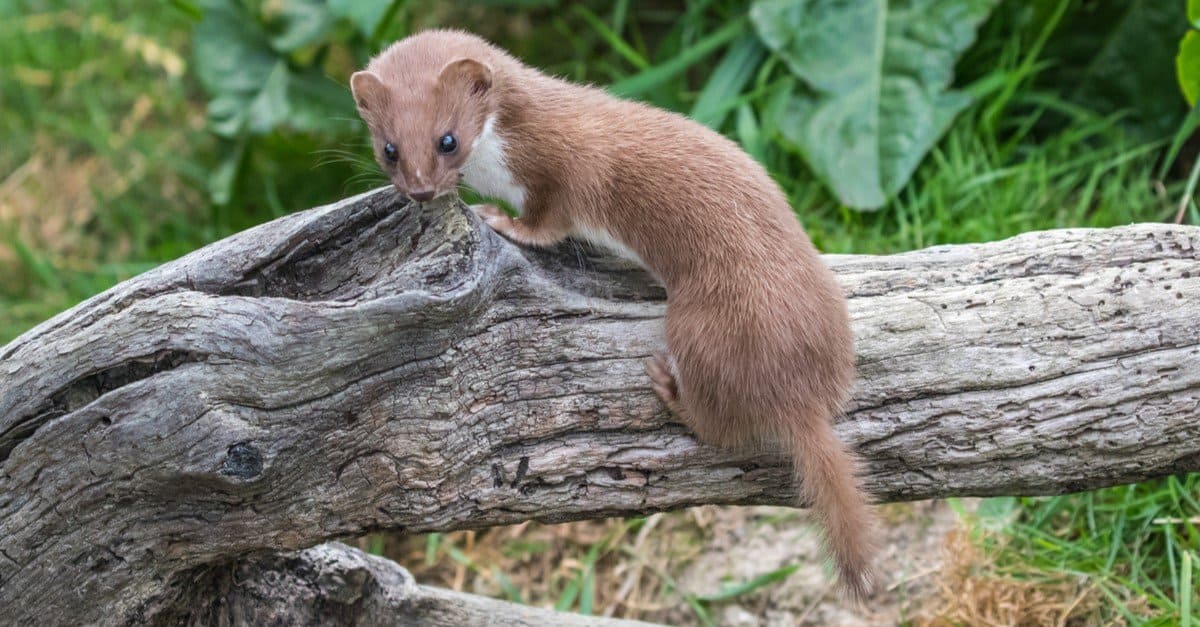
Weasels are carnivores, having very sharp teeth and claws. While older children may understand to be careful around weasels, they are not suitable pets if you have younger children.
©Stephan Morris/Shutterstock.com
Anatomy and Appearance
The Weasel has evolved to prey on small animals like no other carnivore as their long, slender bodies are perfectly suited for following mice into their burrows.
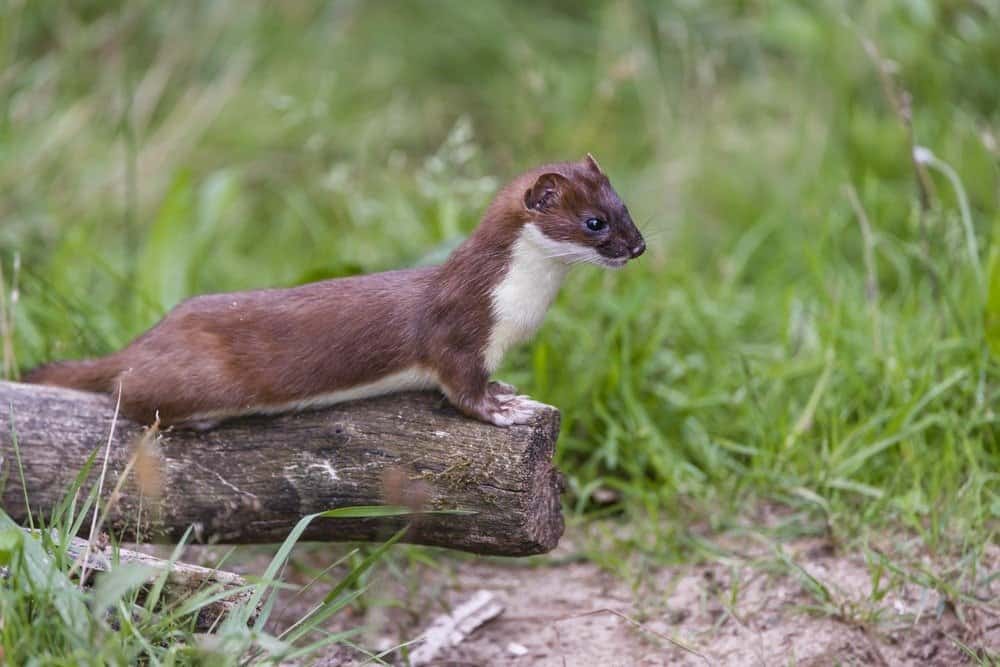
The Weasel has evolved to prey on small animals like no other carnivore as their long, slender bodies are perfectly suited for following mice into their burrows.
©Bildagentur Zoonar GmbH/Shutterstock.com
Weasels are animals with small and narrow heads that are not much thicker than their necks and their short legs and flexible spines mean that they are able to easily maneuver themselves around in small, confined spaces. The Weasel animal has a sharply pointed snout and triangular head, small rounded ears, and black eyes.
Their coat is dark or light brown in color on their head, back, legs, and tail and white on their underside and molts twice a year from the darker winter coat to the flatter, lighter one in April, and again from the summer to the winter coat in August or September.
This not only ensures that by November the Weasel is as warm as possible but in areas further north, individuals will often change from brown to white in color so that they are camouflaged amongst the snow.
Different Types of Weasels
- Ferret
- Stoat
- Least weasel
- European mink
- Black-footed ferret
- Siberian weasel
- Long-tailed weasel
- Japanese weasel
- Mountain weasel
- Polecat–ferret hybrid
- Polecat–mink hybrid
- Steppe polecat
- Colombian weasel
- Egyptian weasel
- Putorius
- Amazon weasel
- Yellow-bellied weasel
- Back-striped weasel
- Malayan weasel
- Indonesian mountain weasel
Distribution and Habitat
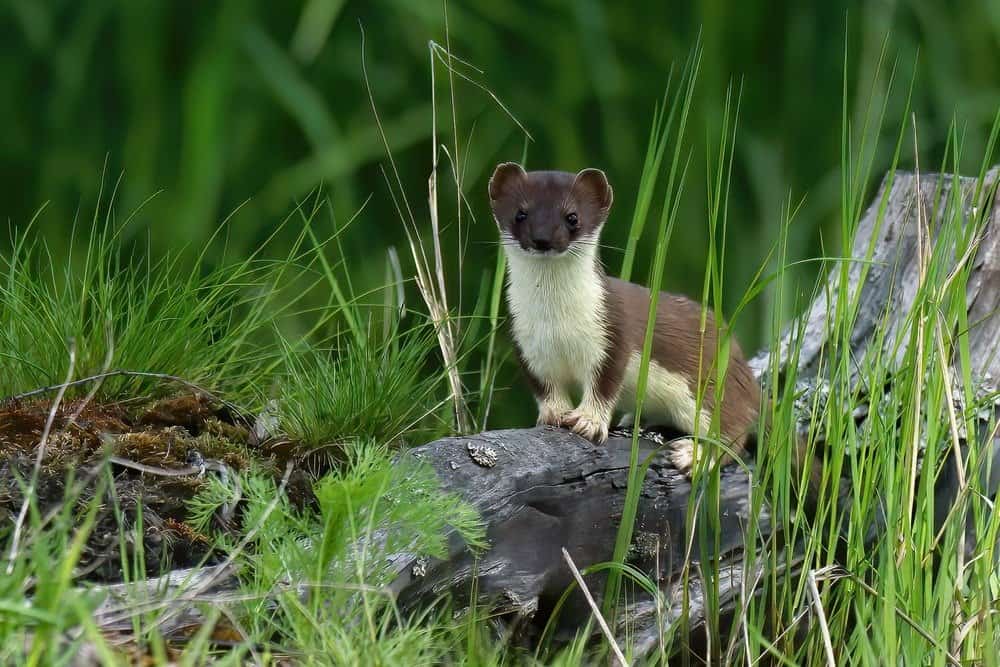
Stoat (Mustela erminea), also called ermine or short-tailed weasel standing on a log among grasses
©Agami Photo Agency/Shutterstock.com
Weasels are animals that are natively found in a variety of habitats such as woodlands, coniferous forests, and on grassy plains in North America, Europe, Asia, and in northern parts of Africa.
Like their larger cousin the Stoat, Weasels have also been introduced to other countries (mainly as a form of pest control) like New Zealand and a number of other islands.
However, like the introduction of a number of small predators to such isolated places, Weasels have had a profound effect on native wildlife which has evolved in the same way for millions of years without the threat of small, terrestrial carnivores.
Weasel animals are opportunistic predators and can also be found in more urban areas and particularly close to farms where there is a varied and tempting supply of food. Despite their adaptability, Weasels are threatened by habitat loss in parts of their natural range.
Behavior and Lifestyle
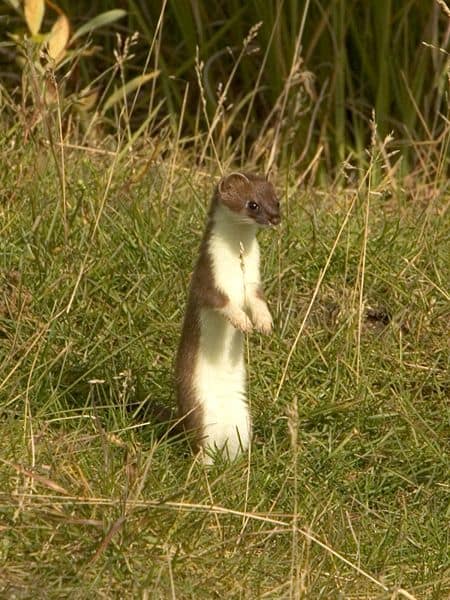
The Weasel is a solitary animal that spends a great deal of its life hunting for small mammals on the ground.
©Steve Hillebrand – Public Domain by U.S. Fish and Wildlife Service
The Weasel is a solitary animal that spends a great deal of its life hunting for small mammals on the ground during both the day and night.
Weasels are territorial animals that patrol home ranges that vary in size depending on the habitat and the availability of food and although the home ranges of males and females are known to overlap, the two tend to avoid each other except when mating.
Within their territory, Weasels are known to make nests in crevices, tree roots, and abandoned burrows which are lined with grass and fur and are where the Weasel is able to safely rest.
Weasels are incredibly strong and powerful for their size and are able to catch and kill animals that are much larger than themselves, before carrying them back to their burrow. In order to make sure that they have the best view of their surroundings, Weasel animals are known to sit up on their hind legs exposing their white underside.
Reproduction and Life Cycles
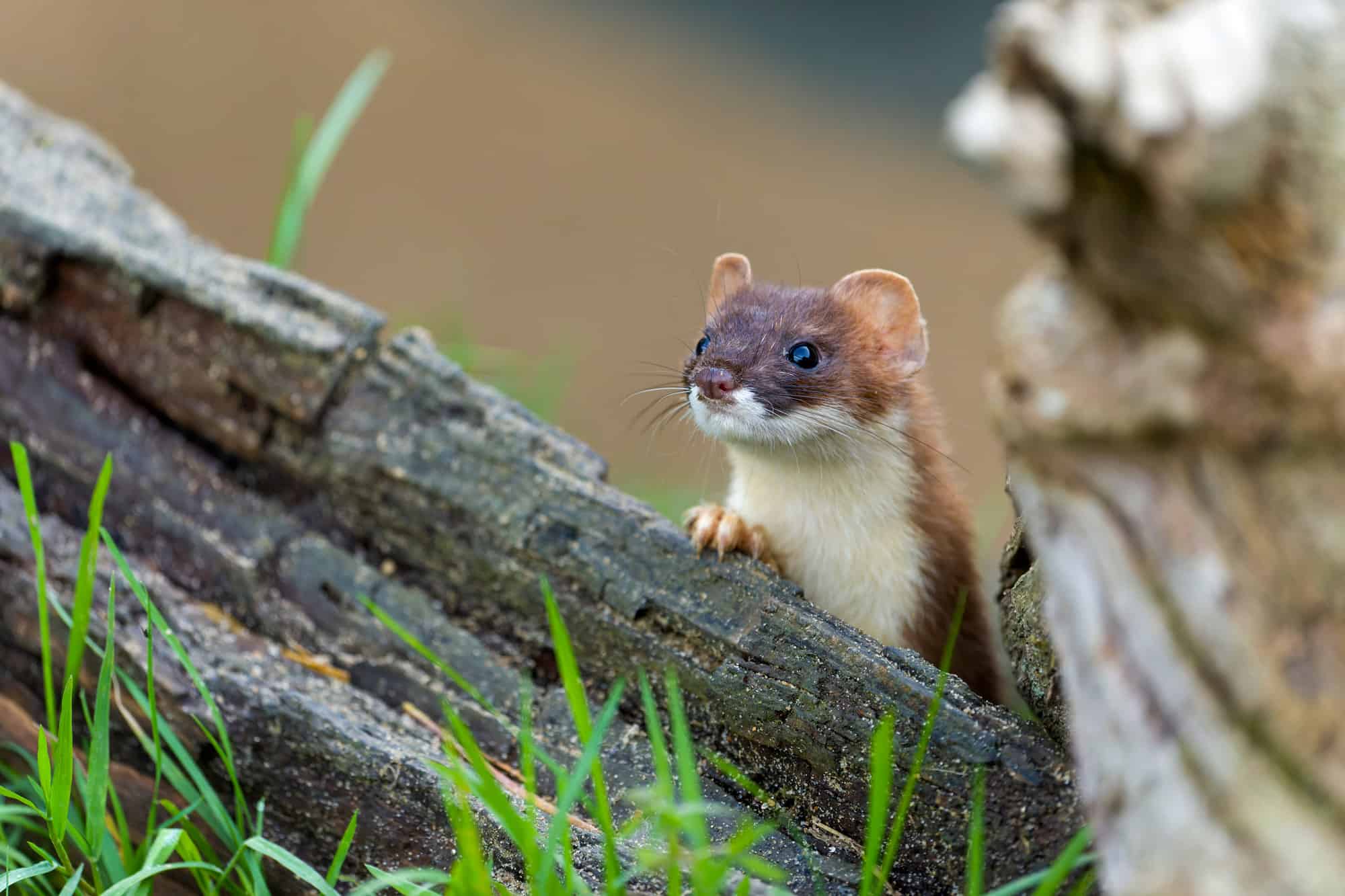
Weasels are animals that are natively found in a variety of habitats such as woodlands, coniferous forests, and on grassy plains
©iStock.com/MikeLane45
The only time Weasels will tolerate one another is when a male and female meet to mate. After a gestation period that lasts for around five weeks, the female Weasel gives birth to a litter of between one and seven kittens in her burrow.
Weasels are also able to hunt small prey and will leave their mother within the next few weeks to establish a territory of their own.
Although female Weasels tend to live for around three years, they are not able to successfully breed until their second and third years. Males, however, will rarely reach their first birthday as their inclination to roam further in search of a mate means that they are often more vulnerable to numerous predators.
Diet and Prey
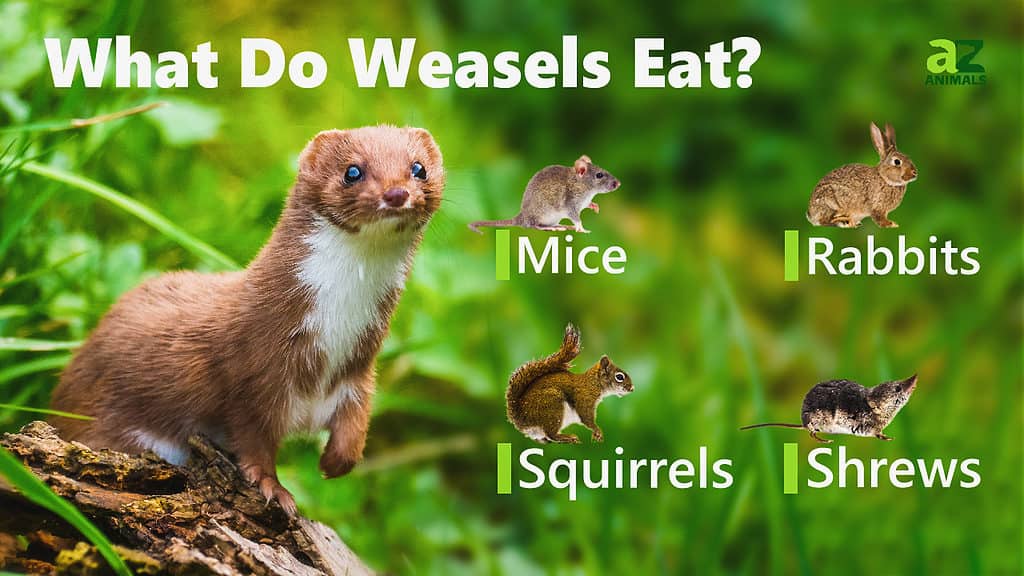
The Weasel is a skilled and ferocious hunter that is able to actually enter the burrows of its prey which is something that most predators are unable to do.
By tracking small mammals using the tunnels that they make through the undergrowth and even under the snow, the Weasel is able to follow its victim back to its burrow and then catch it inside. Rodents such as Mice and Voles, along with Lemmings further north, make up the bulk of the Weasel’s diet along with the occasional bird.
They are also known to eat eggs and are able to kill animals larger than themselves such as Ducks and Rabbits. Although the Weasel may be the perfect shape to get into small burrows, their long body covers a relatively large surface area and so loses a lot of body heat.
In order to ensure that they have enough energy, Weasels must eat around a third of their body weight every day to survive leading to them being such prolific hunters.
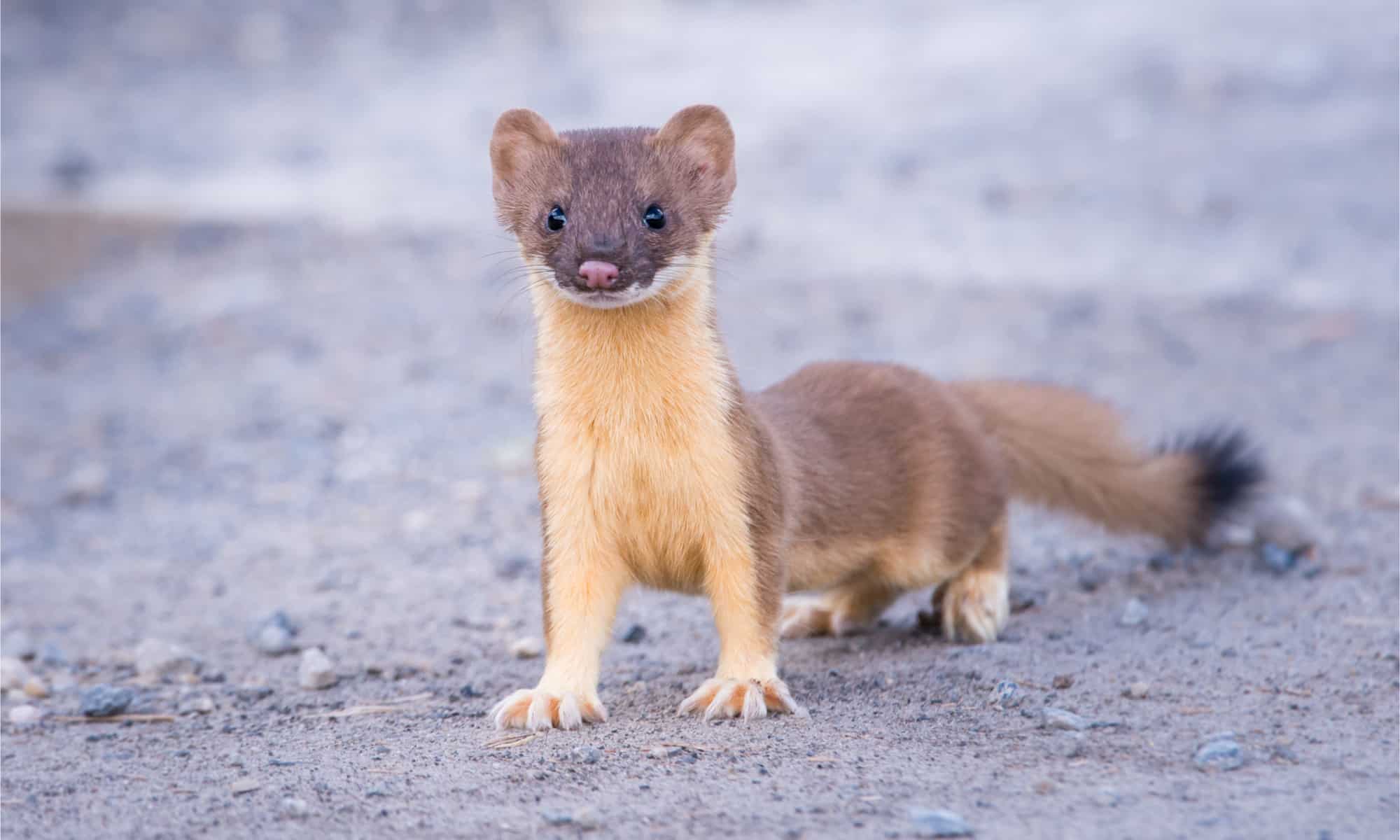
Natural predators to the Weasel animal include birds of prey, foxes, snakes, and domestic cats and dogs.
©Ghost Bear/Shutterstock.com
Predators and Threats
Despite their fast and dexterous nature, the small size of Weasels means that they are preyed upon by a number of different predators throughout their natural range. Birds of Prey such as Owls, Hawks, and Eagles that are able to spot them from high in the sky are the most common predators of the Weasel, along with Foxes and Snakes.
Weasels are also preyed upon by domestic Cats and Dogs in areas where they exist close to Human settlements. Their opportunistic nature though also means that they are seen as pests by farmers and are often persecuted for stealing livestock, mainly poultry and eggs. In some areas around the world, Weasels are threatened by habitat loss and a lack of their prey species can also have devastating effects on local populations.
Interesting Facts and Features
The Weasel is a carnivorous animal that has sharp, pointed canine teeth which are used for biting and shearing flesh. Although small, their teeth are incredibly sharp and are capable of delivering a fatal bite to animals more than double their size. Weasels have five toes on each of their paws that are tipped with small, non-retractable claws.
Although these are primarily used for holding onto prey, their claws also help Weasels to burrow into the ground surprisingly quickly. Although males and females have similar coat colors and markings, males are actually substantially bigger with a body length a quarter longer than that of females and weighing nearly double.
Relationship with Humans
The ferocious and greedy nature of the Weasel has led to them getting a bad reputation amongst farmers, particularly those who trap and kill them to prevent further loss of livestock.
They have, however, been introduced to countries where they are not naturally found due to their versatile and dominant nature as a form of natural pest control. Along with a number of native British species, Weasels are often found as characters in books and appear in children’s songs.
Conservation Status and Life Today
Today, the Weasel is listed by the IUCN as an animal that is of Least Concern of becoming extinct in its natural environment in the near future.
Although they are considered widespread but rare in North America, they are common throughout Europe and Asia, and introduced populations to other countries are also stable. Some isolated populations however are becoming increasingly vulnerable.
View all 108 animals that start with WWeasel FAQs (Frequently Asked Questions)
Are Weasels herbivores, carnivores, or omnivores?
Weasels are Carnivores, meaning they eat other animals.
What Kingdom do Weasels belong to?
Weasels belong to the Kingdom Animalia.
What class do Weasels belong to?
Weasels belong to the class Mammalia.
What phylum to Weasels belong to?
Weasels belong to the phylum Chordata.
What family do Weasels belong to?
Weasels belong to the family Mustelidae.
What order do Weasels belong to?
Weasels belong to the order Carnivora.
What type of covering do Weasels have?
Weasels are covered in Fur.
What genus do Weasels belong to?
Weasels belong to the genus Mustela.
Where do Weasels live?
Weasels live in the Northern Hemisphere.
In what type of habitat do Weasels live?
Weasels live in forests and open woodlands.
What are some predators of Weasels?
Predators of Weasels include hawks, foxes, and snakes.
How many babies do Weasels have?
The average number of babies a Weasel has is 5.
What is an interesting fact about Weasels?
Weasels are the smallest carnivorous mammal in the world!
What is the scientific name for the Weasel?
The scientific name for the Weasel is Mustela nivalis.
What is the lifespan of a Weasel?
Weasels can live for 1 to 3 years.
What is a baby Weasel called?
A baby Weasel is called a kitten.
How many species of Weasel are there?
There are 10 species of Weasel.
What is the biggest threat to the Weasel?
The biggest threat to the Weasel is the lack of prey species.
What is another name for the Weasel?
The Weasel is also called the common weasel, European weasel, or least weasel.
How fast is a Weasel?
A Weasel can travel at speeds of up to 15 miles per hour.
What is the difference between minks and weasels?
Minks differ from weasels in their preferred habitats, diet, and appearance. Read all about their differences here!
What is the difference between stoats and weasels?
Weasels differ from stoats in their sizes, dietary preferences, and reproductive cycles. Read all about their differences here!
What is the difference between weasels and mongoose?
One is a member of the ‘dog-like’ carnivores, caniforma, while the other is a member of the feliforma, or ‘cat-like’ carnivores. But, that’s not all- read all about their differences here!
What are the difference between weasels and ermines?
The greatest differences between an ermine and a weasel are their size and morphology.
What are the differences between pine martens and least weasels?
The differences between pine martens and least weasels include size, appearance, diet, distribution, reproduction cycle, and lifespan.
How to say Weasel in ...
Thank you for reading! Have some feedback for us? Contact the AZ Animals editorial team.
Sources
- David Burnie, Dorling Kindersley (2011) Animal, The Definitive Visual Guide To The World's Wildlife
- Tom Jackson, Lorenz Books (2007) The World Encyclopedia Of Animals
- David Burnie, Kingfisher (2011) The Kingfisher Animal Encyclopedia
- Richard Mackay, University of California Press (2009) The Atlas Of Endangered Species
- David Burnie, Dorling Kindersley (2008) Illustrated Encyclopedia Of Animals
- Dorling Kindersley (2006) Dorling Kindersley Encyclopedia Of Animals
- David W. Macdonald, Oxford University Press (2010) The Encyclopedia Of Mammals
- Weasel Information, Available here: http://www.iucnredlist.org/apps/redlist/details/14021/0

















